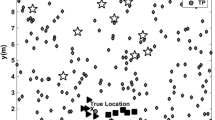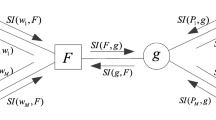Abstract
Massive multiple-input multiple-output (M-MIMO) systems improve positioning accuracy besides enhancing communication performance. Fingerprinting (FP) method is widely used for positioning applications due to its high reliability, cost-efficiency, and accuracy. The FP method based on Gaussian process regression (GPR) could potentially be used in M-MIMO systems to improve positioning accuracy. However, it is limited by high computational complexity. In this paper, an FP positioning method based on the affinity propagation clustering (APC) and GPR is presented to estimate the user’s position in a distributed massive MIMO (DM-MIMO) system from the uplink received signal strength (RSS). In the proposed method, an optimal clustering scheme based on APC is presented to split up the target area into several small regions, which minimizes the searching space of reference points and reduces the computational complexity and position estimation error. Then, a GPR model is created for each region based on the RSS data distribution within each region to provide further positioning accuracy. An improved method based on the K-dimensional tree (KD-tree) is also presented for test users to find their most likely region. Then their positions are estimated based on the GPR model of that region. Simulation results reveal that the proposed scheme improves positioning accuracy significantly compared to using only GPR for the whole target area. This approach has high coverage and improves average root-mean-squared error (RMSE) performance to a few meters, which is expected in 5G networks. Consequently, it also helps to reduce the computational complexity of GPR in the positioning systems.








Similar content being viewed by others
Availability of Data and Material
Not applicable
References
Liu, Y., Shi, X., He, S., & Shi, Z. (2017). Prospective Positioning Architecture and Technologies in 5G Networks. IEEE Network, 31(6), 115–121.
Zhang, P., Lu, J., Wang, Y., & Wang, Q. (2017). Cooperative localization in 5G networks: A survey. ICT Express, 3(1), 27-32.
Nerem, R. S., & Larson, K. M. (2012). Global positioning system: theory and practice. Berlin: Springer.
Cui, Y., & Ge, S. S. (2003). Autonomous vehicle positioning with GPS in urban canyon environments. IEEE Transactions on Robotics and Automation, 19(1), 15–25.
Gaonkar, S., Li, J., Choudhury, R. R., Cox, L., & Schmidt, A. (2008). Micro-blog: sharing and querying content through mobile phones and social participation. In Proceedings of the 6th international conference on Mobile systems, applications, and services, pp. 174–186.
Zanella, A. (2016). Best practice in RSS measurements and ranging. IEEE Communications Surveys Tuts, 18(4), 2662–2686.
So, H. C., & Lin, L. (2011). Linear least squares approach for accurate received signal strength based source localization. IEEE Transactions on Signal Processing, 59(8), 4035–4040.
Li, M., & Lu, Y. (2008). Angle-of-arrival estimation for localization and communication in wireless networks. In Proceedings of 16th European Signal Processing Conference, pp. 1–5.
Chan, Y., & Ho, K. (1994). A simple and efficient estimator for hyperbolic location. IEEE Transactions on Signal processing, 42(8), 1905–1915.
Ning, C., Li, R., & Li, K. (2016). Outdoor location estimation using received signal strength-based fingerprinting. Wireless Personal Communications, 89(2), 365–384.
Savic, V., & Larsson, E. G. (2015). Fingerprinting-based positioning in distributed massive MIMO systems. 82nd vehicular technology conference (VTC2015-Fall), IEEE, pp. 1–5.
Vo, D. Q., & De, P. (2015). A survey of fingerprint-based outdoor localization. IEEE Communications Surveys & Tutorials, 18(1), 491–506.
Ergen, S. C., Tetikol, H. S., Kontik, M., Sevlian, R., Rajagopal, R., & Varaiya, P. (2013). RSSI-fingerprinting-based mobile phone localization with route constraints. IEEE Transactions on Vehicular Technology, 63(1), 423–428.
Zhang, A., Yuan, Y., Wu, Q., Zhu, S., & Deng, J. (2017). Wireless RSSI fingerprinting localization. Signal Processing, 131, 235–244.
Zhang, A., Yuan, Y., Wu, Q., Zhu, S., & Deng, J. (2015). Wireless localization based on RSSI fingerprint feature vector. International Journal of Distributed Sensor Networks, 11(11), 528747.
Wang, X., Gao, L., Mao, S., & Pandey, S. (2016). CSI-based fingerprinting for indoor localization: A deep learning approach. IEEE Transactions on Vehicular Technology, 66(1), 763–776.
Chen, H., Zhang, Y., Li, W., Tao, X., & Zhang, P. (2017). ConFi: Convolutional neural networks based indoor wi-fi localization using channel state information. IEEE Access, 5, 18066–18074.
Mao, G., & Fidan, B. (2009). Localization Algorithms and Strategies for Wireless Sensor Networks: Monitoring and Surveillance Techniques for Target Tracking. Hershey: Hershey.
Lu, L., Li, G. Y., Swindlehurst, A. L., Ashikhmin, A., & Zhang, R. (2014). An overview of massive MIMO: Benefits and challenges. IEEE Journal of Selected Topics in Signal Processing, 8(5), 742–758.
Chen, C. M., Blandino, S., Gaber, A., Desset, C., Bourdoux, A., et al. (2017). Distributed massive MIMO: A diversity combining method for TDD reciprocity calibration. Global Communications Conference (GLOBECOM), IEEE, pp. 1–7.
Kamga, G. N., Xia, M., & Aïssa, S. (2016). Spectral-efficiency analysis of massive MIMO systems in centralized and distributed schemes. IEEE Transactions on Communications, 64(5), 1930–1941.
Joung, J., Chia, Y. K., & Sun, S. (2014). Energy-efficient, large-scale distributed-antenna system (L-DAS) for multiple users. IEEE Journal of Selected Topics in Signal Processing, 8(5), 954–965.
Hu, A., Lv, T., Gao, H., Zhang, Z., & Yang, S. (2014). An ESPRIT-based approach for 2-D localization of incoherently distributed sources in massive MIMO systems. IEEE Journal of Selected Topics in Signal Processing, 8(5), 996–1011.
Shaikh, S. A., & Tonello, A. M. (2016). Localization based on angle of arrival in EM lens-focusing massive MIMO. 6th International Conference on Consumer Electronics-Berlin (ICCE-Berlin), IEEE, pp. 124–128.
Lv, T., Tan, F., Gao, H., & Yang, S. (2016). A beamspace approach for 2-D localization of incoherently distributed sources in massive MIMO systems. Signal Processing, 121, 30–45.
Garcia, N., Wymeersch, H., Larsson, E. G., Haimovich, A. M., & Coulon, M. (2017). Direct localization for massive MIMO. IEEE Transactions on Signal Processing, 65(10), 2475–2487.
Shahmansoori, A., Garcia, G. E., Destino, G., Seco-Granados, G., & Wymeersch, H. (2015). 5G position and orientation estimation through millimeter wave MIMO. In Globecom Workshops (GC Wkshps), IEEE, pp. 1–6.
Guerra, A., Guidi, F., & Dardari, D. (2015). Position and orientation error bound for wideband massive antenna arrays. In IEEE International Conference on Communication Workshop (ICCW), pp. 853–858.
Vieira, J., Leitinger, E., Sarajlic, M., Li, X., & Tufvesson, F. (2017). Deep convolutional neural networks for massive mimo fingerprint-based positioning. In 28th Annual International Symposium on Personal, Indoor, and Mobile Radio Communications (PIMRC), IEEE, pp. 1–6.
Frey, B. J., & Dueck, D. (2007). Clustering by passing messages between data points. Science, 315(5814), 972–976.
Kumar, S., Hegde, R. M., & Trigoni, N. (2016). Gaussian process regression for fingerprinting based localization. Ad Hoc Networks, 51, 1–10.
Yiu, S., & Yang, K. (2015). Gaussian process assisted fingerprinting localization. IEEE Internet of Things Journal, 3(5), 683–690.
Rasmussen, C. E., & Williams, C. K. I. (2006). Gaussian processes for machine learning (Vol. 2). Cambridge: MIT Press.
Yang, A., Jing, Y., Xing, C., Fei, Z., & Kuang, J. (2015). Performance analysis and location optimization for massive MIMO systems with circularly distributed antennas. IEEE Transactions on Wireless Communications, 14(10), 5659–5671.
Prasad, K. S. V., Hossain, E., & Bhargava, V. K. (2017). A numerical approximation method for RSS-based user positioning in distributed massive MIMO. In International Conference on Advanced Networks and Telecommunications Systems (ANTS), IEEE, pp. 1–6.
Zheng, K., Ou, S., & Yin, X. (2014). Massive MIMO channel models: A survey. In International Journal of Antennas and Propagation.
Ngo, H. Q., Ashikhmin, A., Yang, H., Larsson, E. G., & Marzetta, T. L. (2017). Cell-free massive MIMO versus small cells. IEEE Transactions on Wireless Communications, 16(3), 1834–1850.
Gunnarsson, S., Flordelis, J., Van der Perre, L., & Tufvesson, F. (2018). Channel hardening in massive mimo-a measurement based analysis. In 19th International Workshop on Signal Processing Advances in Wireless Communications (SPAWC), IEEE, pp. 1–5.
Gokcay, E., & Principe, J. C. (2002). Information theoretic clustering. IEEE Transactions on Pattern Analysis and Machine Intelligence, 24(2), 158–171.
Refianti, R., Mutiara, A. B., & Syamsudduha, A. A. (2016). Performance evaluation of affinity propagation approaches on data clustering. International Journal of Advanced Computer Science and Applications, 7(3), 420–429.
Rousseeuw, P. J. (1987). Silhouettes: A graphical aid to the interpretation and validation of cluster analysis. Journal of Computational and Applied Mathematics, 20, 53–65.
David, D. L., & Donald, B. W. (1979). A cluster separation measure. IEEE Transactions on Pattern Analysis and Machine Intelligence, PAMI–1(2), 224–227.
Calinski, R. B., & Harabasz, J. (1974). A dendrite method for cluster analysis. Communications in Statistics-Theory and Methods, 3(1), 1–27.
James, G., Witten, D., Hastie, T., & Tibshirani, R. (2013). An introduction to statistical learning (Vol. 112). Berlin: Springer.
Dhanabal, S., & Chandramathi, S. (2011). A review of various k-nearest neighbor query processing techniques. International Journal of Computer Applications, 31(7), 14–22.
Schulz, E., Speekenbrink, M., & Krause, A. (2018). A tutorial on gaussian process regression: Modelling, exploring, and exploiting functions. Journal of Mathematical Psychology, 85, 1–16.
Rasmussen, C. E. (1999). Evaluation of Gaussian processes and other methods for non-linear regression (Doctoral dissertation). University of Toronto,Toronto, ON., Canada.
Prasad, K. S. V., Hossain, E., & Bhargava, V. K. (2017). Low-dimensionality of noise-free rss and its application in distributed massive mimo. IEEE Wireless Communications Letters, 7(4), 486–489.
Byrd, R. H., Lu, P., Nocedal, J., & Zhu, C. (1995). A limited memory algorithm for bound constrained optimization. SIAM Journal on Scientific Computing, 16(5), 1190–1208.
Pérez-Cruz, F., Van Vaerenbergh, S., Murillo-Fuentes, J. J., Lázaro-Gredilla, M., & Santamaria, I. (2013). Gaussian processes for nonlinear signal processing: An overview of recent advances. IEEE Signal Processing Magazine, 30(4), 40–50.
Access, E. U. T. R. (2010). Further advancements for E-UTRA physical layer aspects (release 9). Document TS, 36(814), 3GPP.
Saitta, S., Raphael, B., & Smith, I. F. (2008). A comprehensive validity index for clustering. Intelligent Data Analysis, 12(6), 529–548.
Acknowledgements
The authors would like to thank NSERC for supporting this research.
Funding
It is provided by Natural Sciences and Engineering Research Council (NSER).
Author information
Authors and Affiliations
Corresponding author
Ethics declarations
Conflict of Interest
There is no Conflicts of interest.
Code availability
Not applicable.
Additional information
Publisher's Note
Springer Nature remains neutral with regard to jurisdictional claims in published maps and institutional affiliations.
Rights and permissions
About this article
Cite this article
Moosavi, S.S., Fortier, P. Fingerprinting Positioning in Distributed Massive MIMO Systems Using Affinity Propagation Clustering and Gaussian Process Regression. Wireless Pers Commun 121, 1835–1855 (2021). https://doi.org/10.1007/s11277-021-08741-4
Accepted:
Published:
Issue Date:
DOI: https://doi.org/10.1007/s11277-021-08741-4




